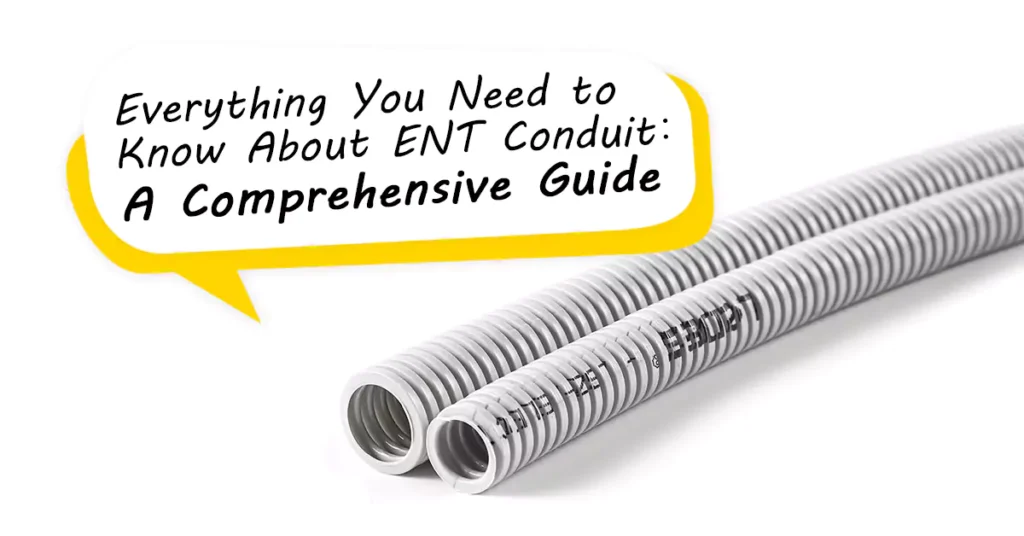
جدول المحتويات
فهم الأنف والأذن والحنجرة
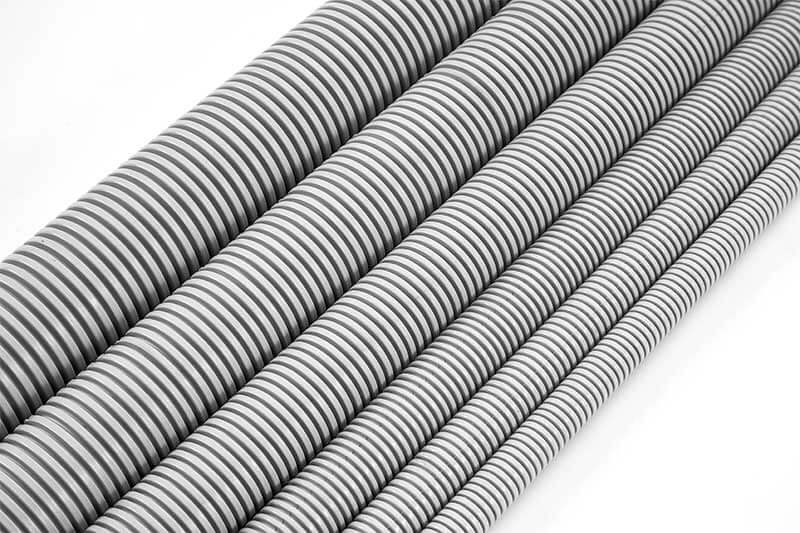
الأنابيب الكهربائية غير المعدنية (ENT) هو نوع من الأنابيب المستخدمة في التركيبات الكهربائية. وهو عبارة عن أنبوب مرن مموج مصنوع من مادة غير معدنية، وعادة ما تكون من البلاستيك عالي الجودة مثل كلوريد البولي فينيل (PVC). يوفر أنبوب ENT العديد من المزايا مقارنة بالأنابيب المعدنية التقليدية. فهو خفيف الوزن، وسهل التعامل معه، ويمكن قطعه وثنيه بسهولة ليناسب متطلبات التركيب المختلفة. تسمح مرونة أنبوب ENT بالتركيب بسهولة في الأماكن الضيقة وحول العوائق. تم تصميم أنبوب ENT لحماية الأسلاك والكابلات الكهربائية وتوجيهها، حيث يعمل كمسار للأسلاك الكهربائية في المباني السكنية والتجارية.
الشهادات المتوافقة ومعايير الاختبار
يمكن أن تختلف معايير الاعتماد والاختبار المطلوبة للأنابيب الكهربائية غير المعدنية (ENT) وفقًا للمنطقة والأكواد الكهربائية المحددة. ومع ذلك، فيما يلي بعض المعايير والاختبارات المشار إليها بشكل شائع للأنف والحنجرة:
- يو ال 1653: UL 1653 هو المعيار المعترف به للأنابيب الكهربائية غير المعدنية (ENT). ويغطي متطلبات السلامة والأداء لمنتجات الأنف والأذن والحنجرة، بما في ذلك الأبعاد والبناء والمواد وطرق الاختبار.
- وكالة الفضاء الكندية C22.2 رقم 227.1: CSA C22.2 رقم 227.1 هو معيار كندي يحدد المتطلبات الخاصة بـ أنابيب غير معدنية تستخدم في الكهرباء التركيبات، بما في ذلك ENT. ويغطي المواد والبناء والأبعاد والأداء وطرق الاختبار الخاصة بـ ENT.
- FT4: لا يقتصر اختبار FT4 على الأنابيب الكهربائية غير المعدنية (ENT) ولكنه اختبار لمقاومة الحريق يستخدم لتقييم خصائص انتشار اللهب للكابلات. يتم إجراء اختبار FT4 عادةً على الكابلات، بما في ذلك تلك التي يمكن تركيبها داخل قنوات الأنف والأذن والحنجرة أو بجانبها.
يعد اختبار FT4 جزءًا من معيار C22.2 رقم 0.3 الصادر عن جمعية المعايير الكندية (CSA)، والذي يغطي اختبارات انتشار اللهب وكثافة الدخان للكابلات. يقيس الاختبار معدل انتشار اللهب للكابل عن طريق تعريضه لمصدر اشتعال لهب رأسي. يقوم الاختبار بتقييم قدرة الكابل على مقاومة انتشار اللهب وإمكانية التسبب في انتشار الحريق في سيناريو التثبيت الرأسي.
- NEC (الكود الكهربائي الوطني): إن NEC هو معيار معتمد على نطاق واسع في الولايات المتحدة ويوفر إرشادات ولوائح للتركيبات الكهربائية. وهي تتضمن متطلبات استخدام القناة، بما في ذلك الأنف والأذن والحنجرة، مثل الحجم المناسب وطرق التثبيت والتأريض.
يعد تلبية هذه المعايير وامتلاك شهادات الامتثال ذات الصلة أمرًا بالغ الأهمية عند اختيار قناة الأنف والأذن والحنجرة.
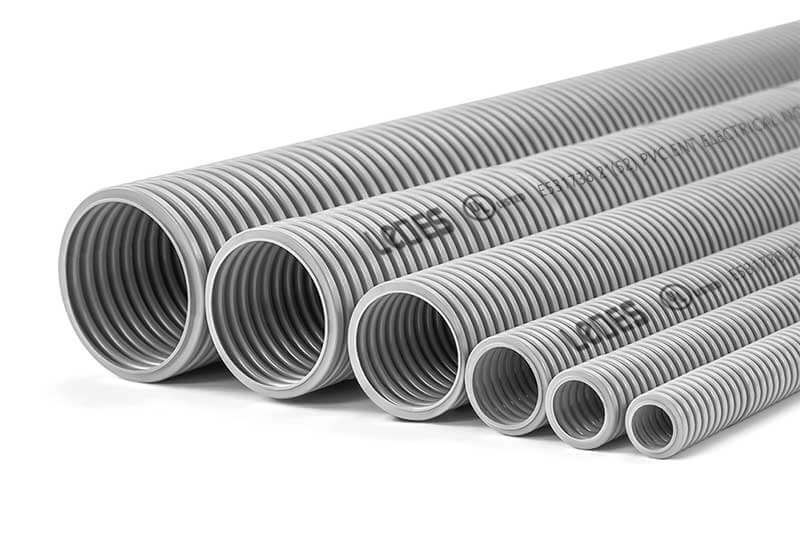
الأحجام العادية لقناة الأنف والأذن والحنجرة
قناة ENT متوفرة بأحجام مختلفة لتلبية متطلبات الأسلاك المختلفة. تشمل الأحجام الأكثر شيوعًا 1/2 بوصة إلى 2-1/2 بوصة. تسمح هذه الأحجام بالمرونة في التوجيه واستيعاب عدد الأسلاك المطلوبة لتطبيق معين.
عملية تصنيع قنوات الأنف والأذن والحنجرة
يتم تصنيع قناة الأنف والأذن والحنجرة من خلال عملية البثق. بالنسبة لقناة ENT PVC، سوف تحتاج إلى:
مواد:
راتينج PVC: المادة الخام الأساسية لأنابيب PVC.
المثبتات: إضافات تعمل على تعزيز استقرار ومتانة مادة البولي فينيل كلوريد (PVC).
المُليّنات: مواد تعمل على تحسين مرونة مادة البولي فينيل كلوريد (PVC).
مواد التشحيم: تستخدم لتسهيل عملية البثق.
الأصباغ: إضافات اختيارية للتلوين.
معدات:
آلة بثق البولي فينيل كلوريد (PVC): وهي آلة تستخدم في إذابة راتنج البولي فينيل كلوريد (PVC) وخلطه مع المواد المضافة.
قالب البثق: يقوم بتشكيل مادة PVC إلى شكل الأنبوب المطلوب.
نظام التبريد: يبرد ويصلب مادة PVC المبثوقة بسرعة.
معدات القطع والتحجيم: تقوم بقطع الأنابيب إلى الطول المطلوب وتضمن الحجم المناسب.
معدات الطباعة: إذا لزم الأمر، المعدات اللازمة لطباعة معلومات المنتج أو العلامات على الأنابيب.
عملية التصنيع يتضمن عمومًا الخطوات التالية:
تحضير: يتم وزن راتنجات PVC والمثبتات والمواد الملينة ومواد التشحيم والأصباغ وخلطها وفقًا لصيغ محددة.
النتوء: يتم إدخال المواد المختلطة إلى جهاز بثق PVC، حيث يتم تسخينها وصهرها. يتم بعد ذلك دفع مادة PVC المنصهرة عبر قالب البثق، والذي يشكلها في شكل القناة.
تبريد: تمر قناة PVC المبثوقة عبر نظام تبريد، والذي يقوم بتبريدها بسرعة لترسيخ الشكل.
القطع والتحجيم: يتم قطع الأنبوب المبرد إلى الطول المطلوب ويخضع للتحجيم للتأكد من أنه يلبي الأبعاد المطلوبة.
الطباعة (إن أمكن): إذا كانت معلومات المنتج أو العلامات مطلوبة على القناة، فيمكن استخدام معدات الطباعة لإضافتها.
ضبط الجودة: يتم إجراء فحوصات الجودة على أنابيب ENT المصنوعة من مادة PVC للتأكد من أنها تلبي المعايير والمواصفات المطلوبة.
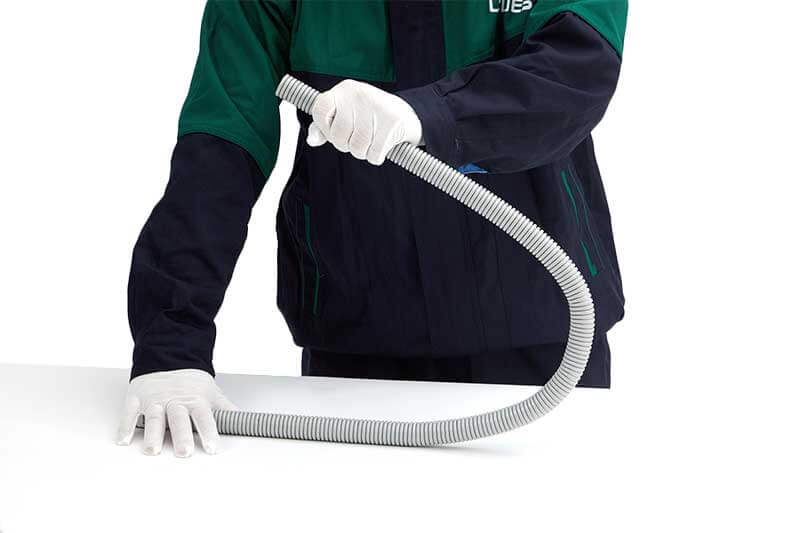
مزايا قناة الأنف والأذن والحنجرة
توفر قناة ENT العديد من المزايا مقارنة بخيارات القناة المعدنية التقليدية. وتشمل هذه:
- المرونة: تتميز قناة الأنف والأذن والحنجرة بالمرونة العالية ويمكن ثنيها يدويًا بسهولة، مما يسهل توجيهها عبر المساحات الضيقة وحول الزوايا، مما يقلل الحاجة إلى التركيبات ويبسط عملية التثبيت.
- المقاومة للتآكل: على عكس الأنابيب المعدنية، فإن أنابيب الأنف والأذن والحنجرة محصنة ضد التآكل، مما يجعلها مناسبة للبيئات الخارجية والرطبة.
- وزن خفيف: يعتبر مجرى الأنف والأذن والحنجرة أخف وزناً بشكل كبير من المجاري المعدنية، مما يسمح بسهولة التعامل والتركيب.
- فعاله من حيث التكلفه: تعتبر أنابيب الأنف والأذن والحنجرة أكثر تكلفة بشكل عام من الأنابيب المعدنية، مما يجعلها خيارًا فعالاً من حيث التكلفة للتركيبات الكهربائية.
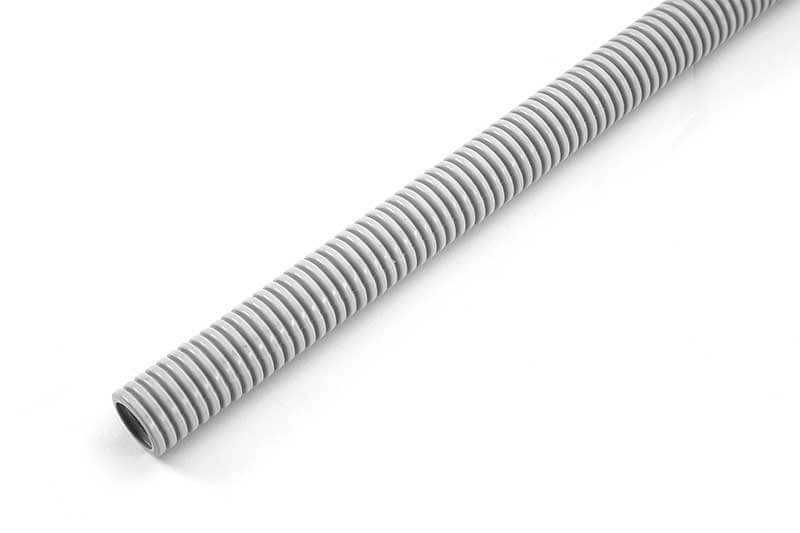
سيناريوهات الاستخدام المشترك
تُعد الأنابيب الكهربائية غير المعدنية (ENT) حلاً متعدد الاستخدامات وفعالًا للتوصيلات الكهربائية يستخدم على نطاق واسع في تطبيقات الأسلاك المختلفة. إن تصميمها المرن ومقاومتها للعوامل البيئية تجعلها خيارًا مثاليًا لكل من البيئات السكنية والتجارية. فيما يلي سيناريوهات الاستخدام الشائعة التفصيلية لأنابيب ENT:
الأسلاك السكنية
يعد أنبوب الأنف والأذن والحنجرة مفيدًا بشكل خاص لأصحاب المنازل الذين يبحثون عن حلول أسلاك فعالة وسرية.
- الأنظمة المتكاملة داخل الحائط: يوفر أنبوب الأنف والأذن والحنجرة توجيهًا سلسًا للتمديدات الكهربائية داخل الجدران، مما يقلل من الحاجة إلى إعادة التوجيه المعقدة حول الأزرار والعقبات المدمجة الأخرى.
- دوائر الحمام والمطبخ: إن مقاومة ENT للرطوبة ومرونتها المدمجة تجعلها مثالية لهذه المناطق ذات الاستخدام العالي، حيث تدعم بشكل آمن الأسلاك الخاصة بالمنافذ والإضاءة والأجهزة.
- الدوائر المخصصة للأجهزة: تسمح تقنية ENT بإنشاء دوائر منظمة ومخصصة للأجهزة الكبيرة، مما يضمن توصيلها بشكل صحيح مع تقليل الفوضى، خاصة في الطوابق السفلية أو غرف المرافق.
التطبيقات التجارية
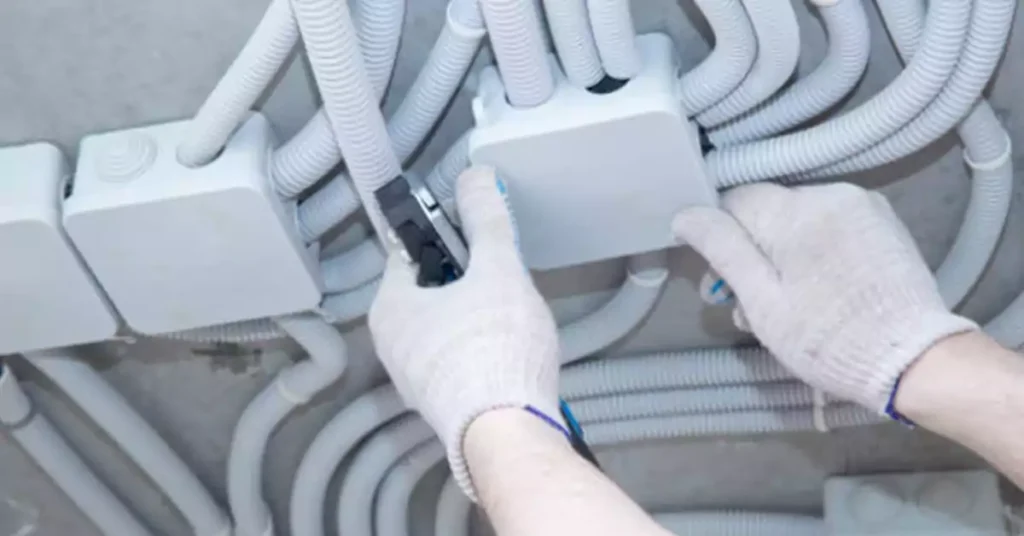
تعتبر أنابيب الأنف والأذن والحنجرة ذات قيمة لا تقدر بثمن أيضًا في المباني التجارية، حيث توفر حلول توصيل فعالة لمختلف احتياجات الأعمال:
- توصيلات المكتب: في بيئات المكاتب، يسهل ENT تنظيم الأسلاك لمحطات العمل وتركيبات الإضاءة وشبكات البيانات. تسمح مرونته بإجراء تعديلات وإعادة تكوينات سهلة مع تغير تخطيطات المكاتب.
- مساحات البيع بالتجزئة: تستفيد مساحات البيع بالتجزئة من قدرة ENT على إنشاء نظام كهربائي نظيف ومنظم. فهو يدعم الأسلاك الخاصة بنقاط البيع، وإضاءة العرض، وأنظمة الأمان، والمزيد، مما يضمن أن التركيب الكهربائي لا يقلل من تجربة التسوق.
- المباني التجارية الخفيفة: تستخدم الشركات الصغيرة، مثل المطاعم وصالونات التجميل والعيادات، تقنية ENT للحصول على حلول توصيل موثوقة. تجعلها قدرتها على التكيف مناسبة للعديد من الإعدادات، من معدات المطبخ إلى أنظمة الإضاءة وتكييف الهواء.
الإعدادات الصناعية
على الرغم من أن ENT قد لا يكون الخيار الأول للتطبيقات الصناعية الثقيلة بسبب قوته المحدودة، إلا أنه لا يزال يجد مجالات محددة:
- أنظمة الجهد المنخفض: يوفر مجرى الأنف والأذن والحنجرة توجيهًا آمنًا وقابلًا للتكيف لأنظمة التحكم والأجهزة ومعدات المراقبة، مما يسمح بالمرونة في وضع المستشعرات وتعديلاتها.
- الآلات الخفيفة والناقلات: في البيئات الخاضعة للرقابة، يمكن أن تحتوي أنابيب الأنف والأذن والحنجرة على أسلاك للآلات الأخف وزناً، وأجهزة الاستشعار، ولوحات التحكم، مما يوفر الحماية والتنظيم مع السماح بالتكيف في المستقبل.
- خطوط البيانات والاتصالات: يتم استخدام ENT بشكل متزايد في خطوط البيانات والاتصالات ذات الجهد المنخفض داخل الإعدادات الصناعية الخاضعة للرقابة، مما يدعم مزيجًا من الإدارة الكهربائية وإدارة البيانات.
تطبيقات في الهواء الطلق
كما أن أنابيب الأنف والأذن والحنجرة مناسبة أيضًا للتركيبات الخارجية، حيث توفر الحماية ضد الرطوبة والعوامل البيئية. وهذا يجعلها خيارًا موثوقًا به للإضاءة الخارجية وإضاءة المناظر الطبيعية وغيرها من الاحتياجات الكهربائية الخارجية.
تركيبات البلاطات الخرسانية
يعد ENT خيارًا شائعًا للتركيبات أسفل ألواح الخرسانة. يسمح تصميمه بتحمل وزن الخرسانة ومقاومة التلف أثناء عملية المعالجة، مما يضمن حلًا كهربائيًا متينًا.
أنابيب الأنف والأذن والحنجرة مقابل الأنابيب المقاومة للسوائل: الاختلافات الرئيسية
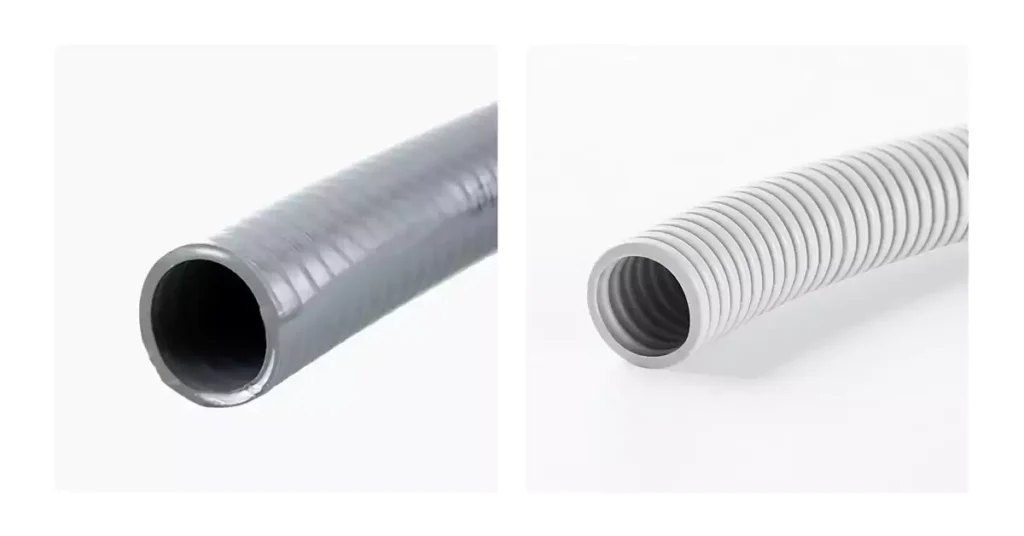
عندما يتعلق الأمر بالتركيبات الكهربائية، فإن اختيار الأنابيب أمر بالغ الأهمية لضمان السلامة والمتانة والامتثال للقواعد الكهربائية. هناك نوعان شائعان من الأنابيب: الأنابيب الكهربائية غير المعدنية (ENT) والأنابيب المقاومة للسوائل. وفي حين أن كليهما يخدمان غرض حماية الأسلاك الكهربائية، إلا أنهما يتمتعان بخصائص مميزة تجعلهما مناسبين لتطبيقات مختلفة.
6 اختلافات بين أنابيب الأنف والأذن والحنجرة والأنابيب المقاومة للسوائل
- تكوين المواد:
- قناة الأنف والأذن والحنجرة: يُعد أنبوب الأنف والأذن والحنجرة المصنوع من البلاستيك المتين خفيف الوزن ومرنًا، وغالبًا ما يتم اختياره للتطبيقات الداخلية.
- أنبوب محكم ضد السوائل: مصنوع من قلب معدني مرن وطبقة خارجية واقية، وهو مقاوم للغاية للماء والزيت والمواد الكيميائية، ومناسب للبيئات الخارجية والرطبة.
- بناء
- الأنف والأذن والحنجرة: يتميز بسطح داخلي أملس يسهل عملية سحب الأسلاك ويتوفر غالبًا بأقطار مختلفة.
- أنبوب محكم ضد السوائل: يتضمن تصميمًا مقاومًا للماء مع سطح خارجي أملس أو مموج، مما يوفر حماية إضافية ضد العوامل البيئية.
- مقاومة الحريق
- الأنف والأذن والحنجرة: يتمتع عمومًا بمعدل مقاومة أقل للحريق، ويعتمد ذلك في المقام الأول على المنتج المحدد والشركة المصنعة.
- أنبوب محكم ضد السوائل: يوفر عادةً مقاومة أفضل للحرائق، وخاصةً في الخيارات المعدنية، مما يجعله أكثر ملاءمة للبيئات عالية المخاطر.
- المقاومة للتآكل
- الأنف والأذن والحنجرة: مقاوم للتآكل بشكل طبيعي، مما يجعله مثاليًا للأماكن الرطبة أو المبللة.
- أنبوب محكم ضد السوائل: كما أنها مقاومة للتآكل، ولكن الإصدارات المعدنية قد تكون عرضة للتآكل مع مرور الوقت إذا تعرضت لمواد كيميائية قاسية.
- المرونة والقوة
- الأنف والأذن والحنجرة: تشتهر هذه الأنابيب بمرونتها العالية، ومن السهل توجيهها حول العوائق وداخل الجدران. ومع ذلك، فإنها تفتقر إلى القوة البنيوية التي تتمتع بها الأنابيب المعدنية.
- أنبوب محكم ضد السوائل: يوفر مرونة معتدلة مع متانة إضافية، ويتحمل بشكل جيد البيئات التي تتطلب مقاومة التأثيرات المادية.
- تحمل درجة الحرارة
- الأنف والأذن والحنجرة: يؤدي أفضل أداء في البيئات التي يتم التحكم في درجة حرارتها ويمكن أن يصبح هشًا في درجات الحرارة القصوى.
- أنبوب محكم ضد السوائل: تم تصميمه للتعامل مع نطاق أوسع من درجات الحرارة، وهو مناسب للاستخدام في الظروف الداخلية والخارجية، بما في ذلك التعرض لتقلبات درجات الحرارة.
أفضل التطبيقات المناسبة
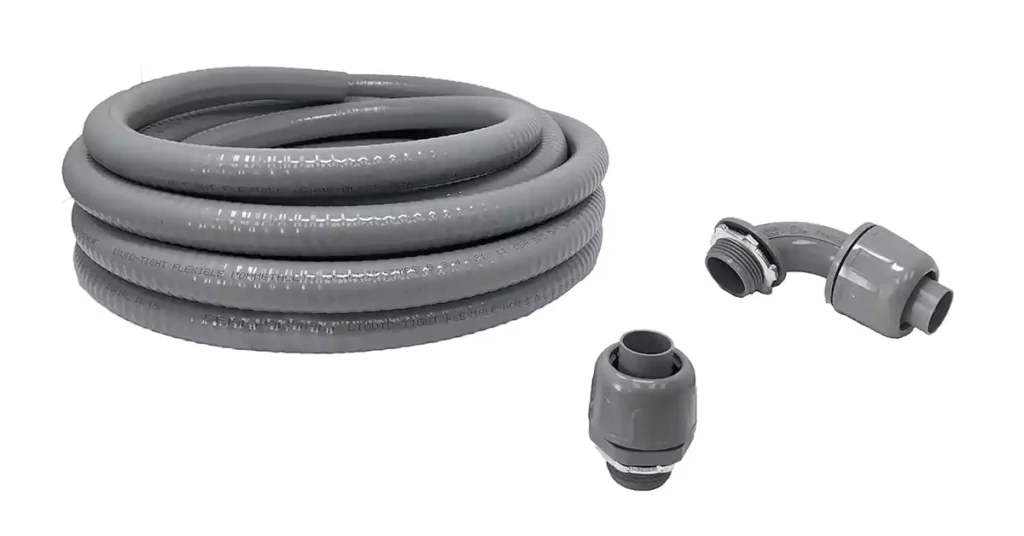
الأنابيب الكهربائية غير المعدنية (ENT)
يُعد ENT هو الخيار الأفضل للتطبيقات الداخلية حيث تكون المرونة وسهولة التركيب من الأولويات. تشمل الاستخدامات الشائعة ما يلي:
- التمديدات الكهربائية السكنية في الجدران والأسقف.
- تطبيقات الجهد المنخفض.
- المناطق التي تتواجد فيها الرطوبة ولكن ليست مفرطة.
أنبوب محكم ضد السوائل
تعتبر الأنابيب المقاومة للسوائل مثالية للبيئات التي يكون فيها التعرض للرطوبة أو المواد الكيميائية أو التلف المادي أمرًا مثيرًا للقلق. تشمل التطبيقات الشائعة ما يلي:
- التركيبات الخارجية والمناطق المكشوفة.
- الأماكن الصناعية حيث قد تتعرض المعدات الكهربائية للانسكاب أو عمليات التنظيف القاسية.
- الأماكن الرطبة كما هو محدد في قانون الكهرباء الوطني (NEC).
متطلبات الكود الكهربائي لتركيب ENT
يعد التركيب الصحيح أمرًا بالغ الأهمية ليس فقط لإطالة عمر الأنابيب ولكن أيضًا لسلامة ووظائف النظام الكهربائي. فيما يلي بعض خطوات واعتبارات التركيب الأساسية لضمان إعداد أنظمة ENT بشكل آمن ومتوافق.
الخطوات الرئيسية في تركيب أجهزة الأنف والأذن والحنجرة
تتبع عملية تركيب أنابيب الأنف والأذن والحنجرة عادةً الخطوات الأساسية التالية لضمان الأداء والامتثال للمدونة الكهربائية الوطنية (NEC) وأي لوائح محلية:
- تخطيط التصميم: قم بتحديد مسار القناة، مع الأخذ في الاعتبار أعمدة الحائط، والعوارض الخشبية، والمكونات الهيكلية الأخرى، وضمان الحد الأدنى من الانحناءات لتقليل الضغط على الأسلاك.
- قطع وتركيب الأنابيب: قم بقطع الأنابيب إلى الأطوال المناسبة باستخدام قاطع الأنابيب، ثم استخدم التركيبات المعتمدة لتوصيل الأقسام وتشكيل الزوايا المطلوبة.
- تأمين القناة: قم بتركيب القناة باستخدام المشابك أو الأقواس أو المعلقات المناسبة، مع الالتزام بمتطلبات التباعد للدعم - عادةً كل 3-4 أقدام أو كما هو محدد بواسطة NEC.
- التوصيل بالصناديق والتجهيزات: قم بتأمين الأنابيب إلى صناديق الوصلات أو التركيبات باستخدام موصلات معتمدة، مع التأكد من أن الوصلات محكمة ومقاومة للرطوبة من أجل المتانة والسلامة.
- سحب الأسلاك: قم بسحب الأسلاك بعناية عبر مجرى الأنف والأذن والحنجرة، مع مراعاة سلامة العزل. قد تقيد إرشادات التعليمات البرمجية أنواعًا أو أحجامًا معينة من الكابلات للاستخدام داخل مجرى الأنف والأذن والحنجرة، لذا تحقق من التوافق.
- التفتيش والاختبار: بمجرد التثبيت، قم بفحص مسار الموصل بالكامل للتأكد من الاستمرارية والتجهيزات الآمنة والالتزام بالكود قبل الانتهاء من الأسلاك.
اعتبارات رئيسية لتركيب قنوات الأنف والأذن والحنجرة
الدعم والتباعد: التزم بمسافة الدعم المطلوبة لمنع ترهل أو حركة الأنابيب، مما قد يؤدي إلى إجهاد الأسلاك أو تلف العزل. قم بالتركيب بشكل آمن، وخاصة في المسارات الأفقية، حيث قد يكون الدعم الإضافي ضروريًا.
نصف قطر الانحناء: اتبع إرشادات التعليمات البرمجية الخاصة بنصف قطر الانحناء الأقصى لتجنب تلف الأسلاك أو الاحتكاك المفرط أثناء السحب. ضع في اعتبارك استخدام صناديق السحب للتشغيلات الطويلة أو التشغيلات ذات الانحناءات المتعددة لتسهيل تركيب الأسلاك بسلاسة وتقليل التآكل المحتمل.
القيود البيئية: يُعد أنبوب الأنف والأذن والحنجرة مثاليًا للتطبيقات الداخلية والجافة، ولكنه قد يتطلب تصنيفات أنابيب محددة أو حماية للأماكن الخارجية أو الأماكن ذات الحرارة العالية أو الرطبة. راجع قيود الكود بناءً على الموقع لضمان التوافق البيئي.
جودة الاتصال: قم بإحكام جميع الوصلات بشكل صحيح لمنع الارتخاء بمرور الوقت. يمكن أن تتسبب التركيبات الفضفاضة في كشف الأسلاك أو التسبب في حدوث أعطال كهربائية، لذا قم بتأمين كل وصلة وفقًا لمتطلبات NEC.
التأريض والترابط: في بعض الحالات، قد يتطلب ENT التوصيل الأرضي، وخاصة في التركيبات حيث يكون استمرارية الأنابيب ضرورية. راجع NEC أو الرموز المحلية لتحديد ما إذا كانت هناك حاجة إلى تدابير توصيل أرضي إضافية بناءً على التطبيق.
التسمية والتعريف: بالنسبة للتركيبات المعقدة، يؤدي وضع العلامات على أقسام الأنابيب وصناديق الوصلات إلى تحسين كفاءة الصيانة والامتثال لمتطلبات الكود الخاصة بالتتبع.
استكشاف الأخطاء وإصلاحها في مشاكل تركيب قنوات الأنف والأذن والحنجرة الشائعة
حتى مع التخطيط الدقيق، قد تواجه تركيبات طب الأنف والأذن والحنجرة تحديات. فيما يلي بعض المشكلات الشائعة وكيفية معالجتها:
التركيبات أو الوصلات الفضفاضة: قد تؤدي التوصيلات غير المحكمة إلى إزاحة الأنابيب أو حدوث فجوات، مما يعرض سلامة التركيب للخطر. أعد فحص التركيبات والموصلات، وتأكد من أنها معتمدة وفقًا للكود ومثبتة بشكل آمن.
سحب الأسلاك الصعبة: إذا كان من الصعب سحب الأسلاك، فتحقق من وجود انحناءات مفرطة أو مسارات طويلة للأنابيب بدون صناديق سحب أو حواف مقطوعة بشكل غير منتظم. قم بتزييت الأسلاك إذا كان ذلك مسموحًا به بموجب القانون، أو أضف صناديق سحب حسب الحاجة.
ترهل القناة: إذا كان أنبوب الأنف والأذن والحنجرة يتدلى بين الدعامات، فراجع المسافة وأضف دعامات إضافية إذا لزم الأمر. يمكن أن يؤدي الترهل إلى الضغط على الأسلاك، مما يزيد من خطر تلف العزل أو تآكل الأسلاك.
تسرب الرطوبة في الأماكن الخارجية أو الرطبة: بالنسبة للتركيبات في البيئات الرطبة، تأكد من أن جميع التركيبات والأختام مقاومة للماء وتتوافق مع متطلبات الكود لحماية الرطوبة. يوصى عمومًا باستخدام أنابيب الأنف والأذن والحنجرة في الأماكن الجافة، لذا كن حذرًا عند التخطيط للبيئات الرطبة أو الخارجية.
أضرار في القناة: قد يتلف أنبوب الأنف والأذن والحنجرة أثناء التركيب أو في حالة تعرضه لمناطق ذات تأثير كبير. افحص الأنبوب بحثًا عن أي شقوق أو تآكلات، واستبدل الأقسام التالفة للحفاظ على السلامة الكهربائية.
قطع قنوات الأنف والأذن والحنجرة: نصائح وتقنيات
إن تحقيق قطع نظيفة ودقيقة في أنابيب الأنف والأذن والحنجرة أمر حيوي لتركيب سلس. يمكن أن تؤدي القطع غير السليمة إلى حواف غير منتظمة، مما يتسبب في صعوبات في تركيب الوصلات وقد يعرض سلامة الأنابيب للخطر بمرور الوقت. بالإضافة إلى ذلك، تضمن القطع الدقيقة اتصالاً آمنًا بالتجهيزات، مما يقلل من خطر المخاطر الكهربائية وتسرب الرطوبة والحفاظ على الامتثال لمعايير NEC.
أدوات لقطع قنوات الأنف والأذن والحنجرة
يمكن للعديد من الأدوات قطع أنابيب الأنف والأذن والحنجرة بفعالية، ولكل منها مزايا فريدة. وفيما يلي تفصيل لهذه المزايا:
- قواطع قنوات الأنف والأذن والحنجرة: تم تصميم هذه القواطع خصيصًا لهذه المهمة، حيث توفر قطعًا سلسة بسرعة وبأقل جهد.
- منشارا: أداة أكثر سهولة في الوصول إليها، على الرغم من أنها قد تترك حواف خشنة تتطلب إزالة النتوءات الإضافية.
- قواطع الأنابيب الدوارة: تشتهر هذه القواطع بالدقة، وغالبًا ما يتم تفضيلها في حالة الأنابيب ذات القطر الصغير. وهي تعمل بشكل جيد مع المواد البلاستيكية الأكثر ليونة.
- سكين متعددة الأغراض: مفيد لتسجيل أقطار الأنابيب الصغيرة؛ فهو ليس الخيار الأكثر كفاءة ولكن يمكن أن يكون خيارًا عمليًا في حالة الضرورة.
تقنيات أساسية لقص الشعر بكفاءة
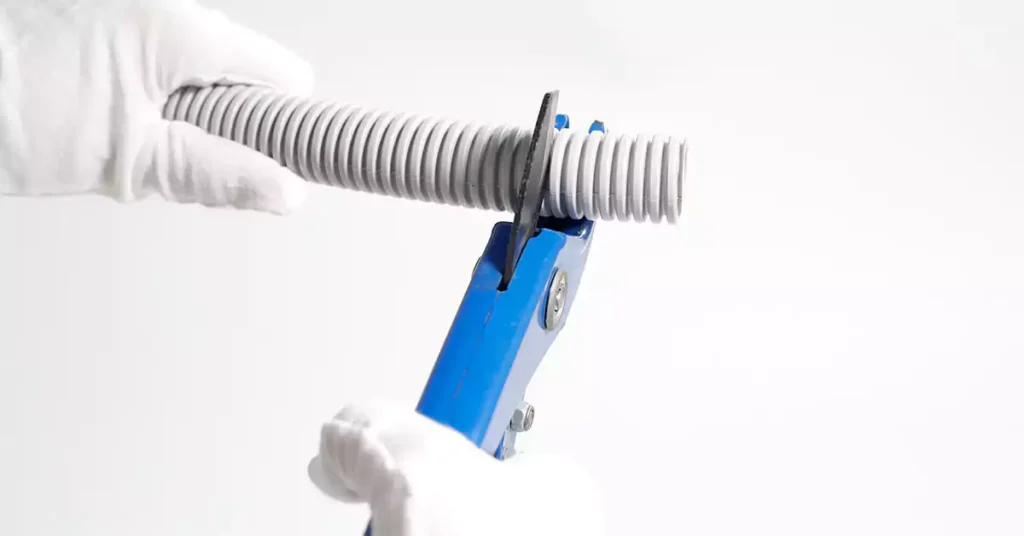
لضمان أن تكون قطع قنوات الأنف والأذن والحنجرة سلسة ودقيقة، إليك بعض أفضل الممارسات:
- قياس مرتين وقطع مرة واحدة: الدقة في القياس ضرورية للتثبيت الصحيح. قم بتحديد خط القطع المطلوب بوضوح باستخدام قلم رصاص أو قلم تحديد.
- تثبيت القناة: قم بتأمين الأنبوب بشكل محكم لمنع حركته أثناء القطع، مما قد يؤدي إلى حواف غير متساوية.
- تدوير الأنبوب (إذا كان ذلك ممكنًا): بالنسبة لبعض طرق القطع، فإن تدوير الأنبوب أثناء تطبيق ضغط لطيف يمكن أن يؤدي إلى قطع أكثر سلاسة.
- إزالة النتوءات من الحواف: بعد القطع، استخدم أداة إزالة النتوءات أو ورق الصنفرة لتنعيم أي حواف خشنة، مما قد يمنع الإصابات ويضمن ملاءمة محكمة مع التركيبات.
السلامة أولاً
عند العمل باستخدام أنابيب الأنف والأذن والحنجرة، يجب أن تكون السلامة دائمًا على رأس الأولويات. وفيما يلي بعض نصائح السلامة:
ارتداء معدات الحماية: توفر لك نظارات السلامة والقفازات وقناع الغبار الحماية من الحواف الحادة والحطام وأي جزيئات صغيرة قد تنتقل في الهواء أثناء القطع.
تأمين مساحة العمل: تأكد من أن مساحة العمل الخاصة بك خالية من أي عوائق وتتمتع بإضاءة جيدة لمنع الإصابات العرضية.
تعامل مع الشفرات بعناية: تتطلب الأدوات الحادة التعامل بحذر، لذا استخدم دائمًا التقنية المناسبة وقم بتخزين الأدوات بشكل آمن عند عدم استخدامها.
تأمين أنابيب الأنف والأذن والحنجرة على الأسطح: المشابك والدعامات
لماذا يعد تأمين الأنابيب بشكل صحيح أمرًا ضروريًا
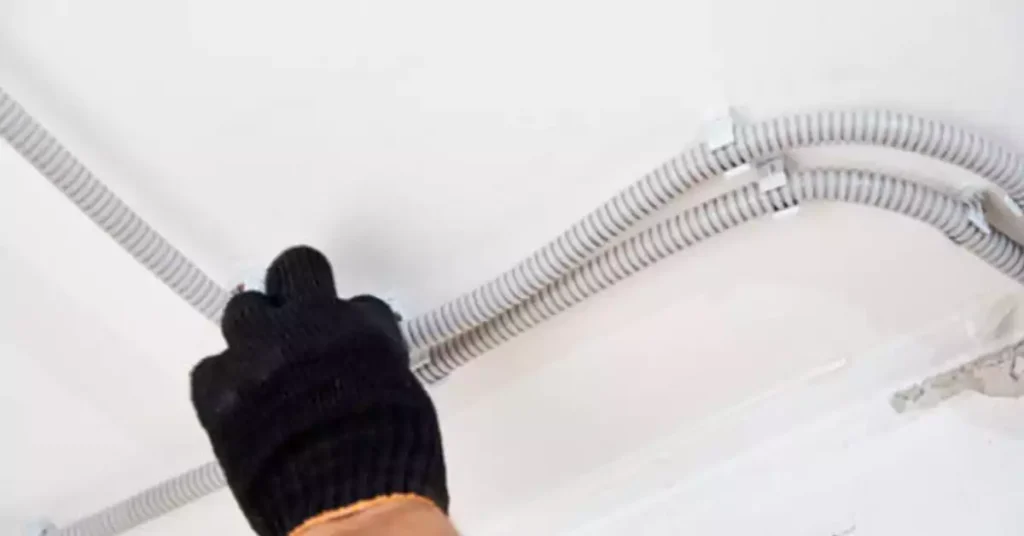
لا يعمل تركيب الأنابيب بشكل صحيح على حماية الأسلاك الكهربائية فحسب، بل يمنع أيضًا الضغوط المادية المختلفة التي قد تؤدي بخلاف ذلك إلى مخاطر السلامة. قد تتأرجح أنابيب الأنف والأذن والحنجرة غير المؤمنة بشكل كافٍ أو تتدلى أو تحتك بالأسطح، مما قد يؤدي إلى إتلاف الأنابيب والأسلاك الموجودة بالداخل. يؤدي هذا النوع من الحركة إلى إدخال عوامل خطر للمخاطر الكهربائية والتآكل الميكانيكي بمرور الوقت، مما يجعل استراتيجية التركيب الموثوقة أمرًا بالغ الأهمية.
الاستقرار الوظيفي والسلامة
للحفاظ على سلامة النظام، يجب تثبيت أنابيب الأنف والأذن والحنجرة بشكل آمن لمقاومة الحركة والانحناء والترهل. وهذا أمر بالغ الأهمية بشكل خاص للأحمال الكهربائية الثقيلة، حيث يمكن للوزن الإضافي أن يسحب الأنابيب إلى الأسفل إذا تُركت بدون دعم. يقلل التثبيت الموثوق به من هذه المخاطر ويطيل عمر التركيب، مما يحافظ على الأسلاك محمية ووظيفية.
الأدوات الأساسية وأنواع المشابك والدعامات
تم تصميم مجموعة من المشابك والمشابك خصيصًا لإبقاء أنابيب الأنف والأذن والحنجرة مثبتة بإحكام على الأسطح مثل الجدران والأسقف والعوارض الهيكلية. فيما يلي نظرة على أدوات التثبيت الأكثر استخدامًا:
مشابك الحزام: توفر هذه المشابك متعددة الاستخدامات والملفوفة طريقة مباشرة لتأمين قناة الأنف والأذن والحنجرة، وعادةً ما يتم تثبيتها بمسمار أو مسمار واحد للتثبيت السريع.
المشابك C: توفر المشابك على شكل حرف C قوة قبضة إضافية لتحقيق الاستقرار، وهي مفيدة بشكل خاص في التركيبات التي قد تواجه اهتزازات أو ضغطًا طفيفًا.
حاملات الأنابيب: عند تعليق أنابيب الأنف والأذن والحنجرة من الأعلى (على سبيل المثال، في الأقبية أو تحت الأرضيات)، فإن حوامل الأنابيب ضرورية. تأتي هذه الحوامل بأنواع مختلفة، بما في ذلك:
- شماعات الأسلاك: حلقات من الأسلاك تمر عبر الأنابيب وتوفر حلاً بسيطًا، وغالبًا ما تستخدم في تطبيقات الأحمال الأخف.
- حاملات الأنابيب المعدنية: بالنسبة للتطبيقات الأكثر قوة، توفر الشماعات المعدنية أذرعًا قابلة للتعديل لتحديد المواقع بدقة والدعم الآمن، وهي مناسبة لمسارات الأنابيب الأكبر حجمًا.
لتثبيت هذه المكونات، من الضروري استخدام مثقاب ورؤوس مثقب ذات حجم مناسب لإنشاء فتحات التثبيت في الأسطح وربط البراغي أو المسامير دون إتلاف الأنابيب أو المواد المحيطة بها.
تقنيات التركيب لتحقيق الاستقرار الأمثل
للحصول على تثبيت موثوق، ضع في اعتبارك استراتيجيات التثبيت التالية التي تعمل على تعزيز الأمان والأداء:
متطلبات التباعد: قم بتوزيع المشابك والمشابك بشكل مناسب - عادةً كل 4-6 أقدام - للحصول على دعم فعال والحفاظ على مستوى الأنابيب. تمنع هذه المسافة الترهل، خاصة في المسارات التي تمتد لمسافات أطول.
التكيف مع نوع السطح: قم باختيار أدوات التثبيت المناسبة بناءً على نوع السطح (على سبيل المثال، البناء، الخشب، الحوائط الجافة) لمنع فشل التثبيت أو الانزلاق.
تجنب الإفراط في الشد: قم بربط أدوات التثبيت بشكل محكم ولكن تجنب الإفراط في الربط، مما قد يؤدي إلى إتلاف كل من القناة وسطح التثبيت، مما قد يؤدي إلى فشل مبكر.
التركيبات وصناديق الوصلات للتركيبات الاحترافية
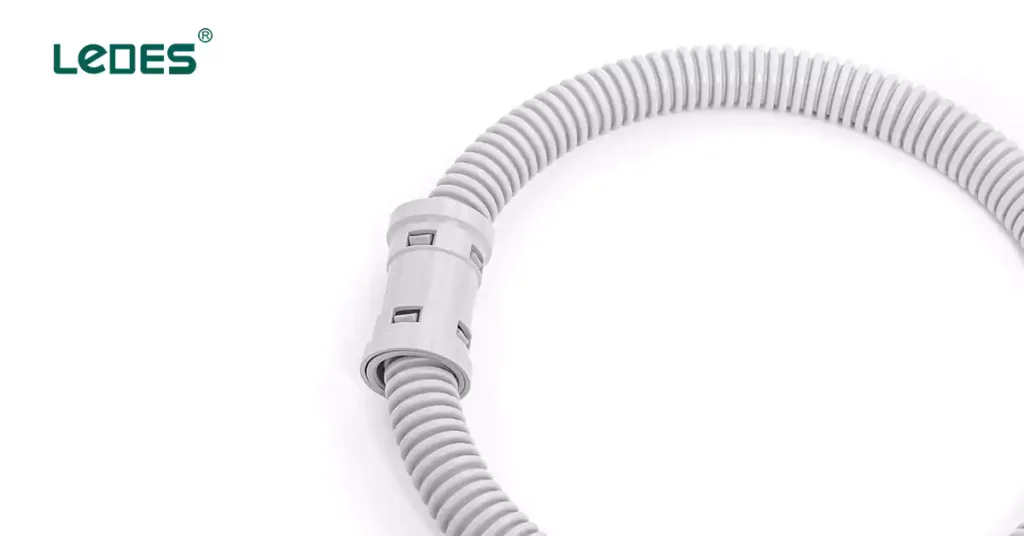
لإكمال نظام توصيل آمن، تعتبر التركيبات وصناديق الوصلات مكونات أساسية تضمن اتصالات مستقرة وتغييرات في الاتجاه:
تجهيزات الأنف والأذن والحنجرة: تم تصميم هذه التركيبات لتثبيت الأنابيب في مكانها عند المفاصل والزوايا والانحناءات، وتحافظ على أنابيب الأنف والأذن والحنجرة في مكانها وتمنع الانفصال. كما تتوفر العديد من التركيبات بخصائص مقاومة للعوامل الجوية والتآكل لضمان المتانة.
صناديق الوصلات: غالبًا ما يتم تركيبها في أماكن التقاء أو تباعد مسارات توصيل متعددة، حيث تعمل صناديق التوصيل على إيواء توصيلات الأسلاك بأمان وتبسيط تنظيم الأسلاك. من أجل الراحة، يمكن لصناديق التوصيل المجهزة مسبقًا بالأسلاك مع الدعم المتكامل لمسارات التوصيل أن تقلل من وقت التركيب وتبسط تكوينات الأسلاك.
نصائح التثبيت لتحقيق الموثوقية على المدى الطويل
للحصول على أقصى استفادة من نظام قنوات الأنف والأذن والحنجرة الخاص بك، ضع في اعتبارك النصائح التالية:
استشر قوانين البناء: تقدم قوانين البناء المحلية متطلبات محددة بشأن تباعد القنوات، وطرق التركيب، وتأمين المواد لضمان التركيبات الآمنة والمتوافقة.
اعتبارات الطقس والبيئة: في البيئات الخارجية أو ذات الرطوبة العالية، اختر الدعامات المقاومة للأشعة فوق البنفسجية أو الرطوبة للحفاظ على طول العمر وتجنب التلف الناتج عن التعرض.
تجنب الانحناءات الحادة: استخدم الانحناءات التدريجية وتجنب الزوايا الحادة في الأنابيب لحماية الأسلاك من الإجهاد أو التآكل الذي قد يؤدي إلى تآكل العزل.
صناديق الوصلات واستخداماتها مع قنوات الأنف والأذن والحنجرة
ما هو صندوق الوصلات؟
صندوق التوصيل هو حاوية واقية حيث يتم وضع توصيلات الأسلاك الكهربائية. عادة ما تكون مصنوعة من مواد متينة مثل المعدن أو البلاستيك، تحمي هذه الصناديق التوصيلات الكهربائية من التلف المادي والمخاطر البيئية والتلاعب غير المصرح به. عند العمل مع أنابيب ENT (أنابيب كهربائية غير معدنية)، تصبح صناديق التوصيل ضرورية للسلامة والوظيفة، حيث توفر وصلات آمنة حيث تلتقي الأسلاك أو تتفرع. في هذا الدليل، سنستكشف سبب أهمية صناديق التوصيل عند تركيب أنابيب ENT، وكيفية اختيار أفضل صندوق لاحتياجاتك، والخطوات اللازمة لتثبيتها بأمان.
لماذا استخدام صناديق الوصلات مع قنوات الأنف والأذن والحنجرة؟
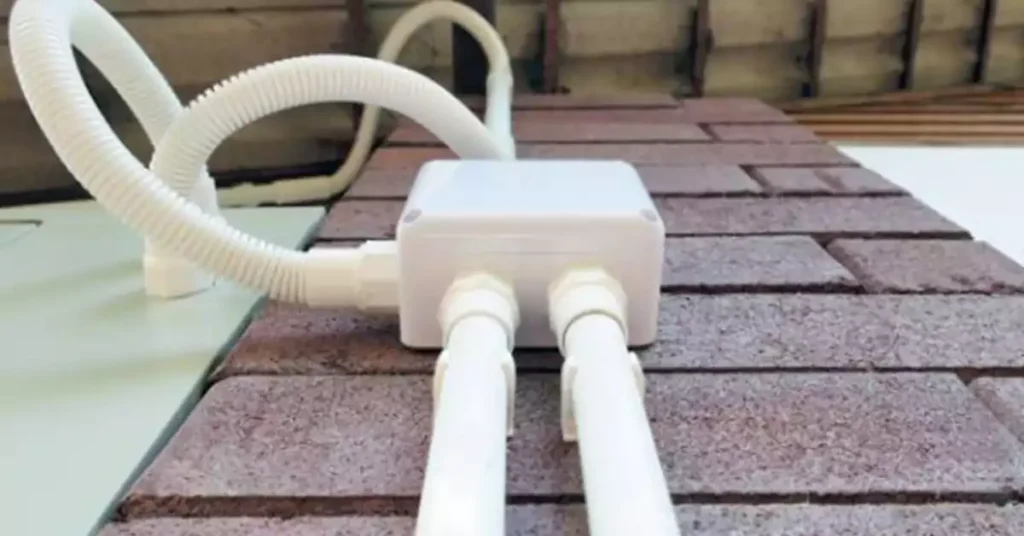
أمان
تقلل صناديق التوصيل من المخاطر الكهربائية من خلال توفير غلاف آمن لتوصيلات الأسلاك، مما يقلل من خطر الصدمات الكهربائية أو الحرائق. كما أنها تمنع التلامس العرضي مع الأسلاك الحية وتحمي من التآكل المادي.
الصيانة المبسطة
من خلال تجميع الاتصالات، تتيح صناديق الوصلات سهولة الوصول إلى الأسلاك لإجراء الإصلاحات أو الترقيات. وهذا مفيد بشكل خاص في التركيبات الكبيرة حيث تتقارب العديد من الأسلاك.
امتثال
في أغلب المناطق، يتطلب الامتثال لقواعد الكهرباء وجود صناديق توصيل لجميع وصلات الأسلاك أو الوصلات. وهذا يضمن أن التركيبات آمنة ومنظمة ومحمية من العوامل الخارجية مثل الغبار والرطوبة والأضرار المادية.
اختيار صندوق التوصيل المناسب لقناة الأنف والأذن والحنجرة
يتضمن اختيار صندوق الوصلات المناسب مراعاة عوامل مثل الموقع والحجم والمادة وأنواع التوصيل:
مادة: غالبًا ما تُستخدم صناديق التوصيل البلاستيكية مع أنابيب الأنف والأذن والحنجرة نظرًا لمقاومتها للتآكل، في حين أن الصناديق المعدنية أفضل للمناطق ذات درجات الحرارة المرتفعة أو متطلبات السلامة من الحرائق الصارمة. تُصنع صناديق التوصيل من Ledes من مادة PVC عالية الجودة، وهي مقاومة للتآكل وأشعة الشمس وغير موصلة للكهرباء، مما يضمن تركيبًا كهربائيًا آمنًا وموثوقًا به.
مقاس: اختر صندوقًا كبيرًا بما يكفي لاستيعاب جميع الأسلاك والتجهيزات دون تكدس. يمكن أن يؤدي تكدس الصناديق إلى زيادة تراكم الحرارة وجعل الصيانة أكثر صعوبة.
تصنيف حماية الدخول (IP): في الأماكن الرطبة أو الخارجية، حدد صندوقًا يتمتع بتصنيف IP مرتفع لضمان قدرته على تحمل التعرض للرطوبة أو الغبار.
خطوات تركيب صناديق الوصلات مع أنابيب الأنف والأذن والحنجرة
- تخطيط الموقع: حدد مكان تركيب صندوق التوصيل، مع التأكد من إمكانية الوصول إليه بسهولة للصيانة المستقبلية. للتثبيت الآمن، استخدم مسمارًا أو أي دعامة هيكلية أخرى.
- تحضير القناة والصندوق: قم بقياس الأنبوب وقطعه بالطول المناسب للتوصيل بصندوق التوصيل. استخدم تجهيزات ENT الخاصة للحصول على توصيل سلس.
- تأمين الصندوق: قم بربط صندوق الوصلات بسطح التثبيت باستخدام البراغي أو المسامير، مع التأكد من أنه مستوٍ وآمن.
- ربط القناة: أدخل أنبوب الأنف والأذن والحنجرة في فتحات الصندوق وقم بربطه بالموصلات المناسبة. تأكد من إحكام جميع التوصيلات واتباع متطلبات NEC (الكود الكهربائي الوطني).
- السلك والإغلاق: داخل الصندوق، قم بتوصيل الأسلاك وتنظيمها حسب الحاجة، باستخدام صواميل الأسلاك لتغطية الوصلات. قم بطي الأسلاك بعناية داخل الصندوق وتأمين الغطاء بإحكام لمنع العبث به وحمايته من الغبار أو الرطوبة.
نصائح السلامة
إيقاف تشغيل الطاقة: قم دائمًا بإيقاف تشغيل الطاقة عند قاطع الدائرة قبل التعامل مع المكونات الكهربائية لتجنب الصدمات الكهربائية أو الإصابات.
استخدم الأدوات المناسبة: استخدم الأدوات المخصصة للأعمال الكهربائية، مثل مفكات البراغي المعزولة ومجردات الأسلاك، لتعزيز السلامة.
تجنب الازدحام: تأكد من أن الصندوق كبير بما يكفي لاستيعاب جميع الأسلاك والموصلات. فالصندوق المزدحم قد يؤدي إلى ارتفاع درجة الحرارة وزيادة خطر نشوب الحرائق.
التحقق من التأريض: يعد التوصيل الأرضي المناسب أمرًا ضروريًا لمنع الصدمات الكهربائية والتأكد من أن جميع التوصيلات آمنة.
سحب الأسلاك عبر قناة الأنف والأذن والحنجرة: التقنيات الأساسية
يتطلب سحب الأسلاك عبر أنابيب الكهرباء غير المعدنية (ENT) تخطيطًا وتقنية دقيقة لضمان تركيب سلس وآمن. يمكن لأنابيب الكهرباء غير المعدنية، المعروفة بمرونتها وتصميمها خفيف الوزن، تبسيط مسارات الأسلاك، ولكنها تتطلب أيضًا معالجة محددة لتجنب تلف الأسلاك أو التشابك. سيغطي هذا الدليل بإيجاز التقنيات والأدوات الرئيسية لسحب الأسلاك بكفاءة عبر أنابيب الكهرباء غير المعدنية.
تقنيات رئيسية لسحب الأسلاك عبر قناة الأنف والأذن والحنجرة
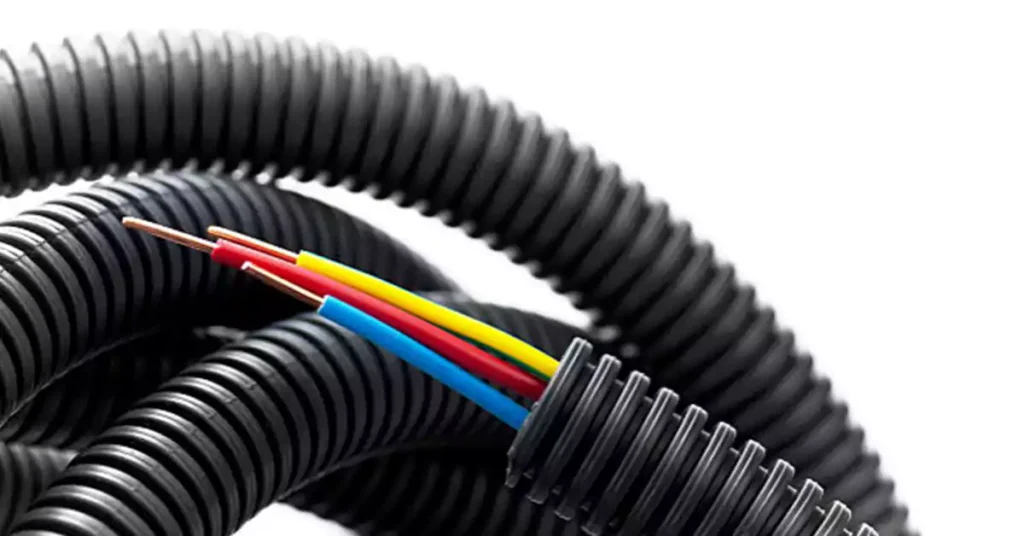
- إعداد مسار القناة
ابدأ بالتأكد من أن الأنبوب خالٍ من العوائق ومثبت بإحكام على طول مساره. تساعد المشابك المتباعدة بشكل صحيح في الحفاظ على الأنبوب مستقيمًا ومنع الانحناءات أو الالتواءات غير المرغوب فيها أثناء سحب الأسلاك. - استخدم مادة التشحيم السحب
يمكن أن يؤدي استخدام مادة تشحيم لسحب الأسلاك إلى تقليل الاحتكاك، وخاصة في المسارات الأطول أو المعقدة. يساعد هذا الأسلاك على الانزلاق بسلاسة عبر الأنابيب دون المخاطرة بتلف العزل. - اختر الأدوات المناسبة
استخدم شريطًا لاصقًا أو خط سحب لتوجيه الأسلاك عبر الأنابيب. يُعد شريط السحب مفيدًا بشكل خاص للمسافات القصيرة، بينما تعمل خطوط السحب بشكل جيد للمسافات الطويلة أو الانحناءات. قم بربط الأسلاك بشكل آمن وقم بتمريرها ببطء لتجنب الالتواءات والتشابك. - اسحب بلطف وبشكل متسق
استخدم ضغطًا ثابتًا ومتساويًا عند السحب لمنع ربط السلك. إذا زادت المقاومة، فتوقف وتحقق من وجود عوائق أو انحناءات ضيقة في الأنبوب قد تحتاج إلى تعديل. - تجنب التحميل الزائد للقناة
راجع إرشادات NEC للتأكد من أن حجم الأنبوب يتوافق مع متطلبات ملء السلك. قد يؤدي التحميل الزائد إلى ارتفاع درجة الحرارة ويجعل الصيانة المستقبلية صعبة.
لمزيد من التفاصيل حول عملية سحب الأسلاك، يرجى الرجوع إلى المقال السابق لكيفية سحب الأسلاك عبر القناة.
حاسبة ملء الأنابيب: تحديد السعة القصوى
عند التخطيط لتركيبات الأنابيب الكهربائية، فإن حساب سعة الأنابيب أمر ضروري لضمان الامتثال لقواعد السلامة ومنع المشكلات المتعلقة بارتفاع درجة الحرارة أو الأسلاك المزدحمة. تساعد حاسبة سعة الأنابيب الكهربائيين والمُثبِّتين على تحديد السعة القصوى للأسلاك لكل حجم أنبوب، مع مراعاة نوع السلك وحجمه وعزله. فيما يلي نظرة عامة سريعة على كيفية عمل حسابات سعة الأنابيب وأهميتها.
نقاط رئيسية لاستخدام حاسبة ملء الأنابيب
- احسب بناءً على نوع وحجم الأنبوب
تختلف سعة ملء المواد المختلفة المستخدمة في الأنابيب (مثل PVC وENT والمعادن) والتي تتغير وفقًا لقطر الأنابيب. تعمل حاسبات ملء الأنابيب على تبسيط هذه العملية من خلال توفير حسابات مخصصة لكل نوع وحجم. - ضع في اعتبارك حجم السلك ونوع العزل
يؤثر مقياس السلك (الحجم) ونوع العزل على مقدار المساحة التي يشغلها كل سلك داخل الأنبوب. تأخذ الآلات الحاسبة هذه الأمور في الاعتبار لضمان عدم تكديس الأسلاك بشكل محكم للغاية، مما يقلل من خطر ارتفاع درجة الحرارة. - الالتزام بإرشادات NEC
تساعد حاسبات ملء الأنابيب في ضمان الامتثال لإرشادات قانون الكهرباء الوطني (NEC)، والتي تحدد النسب المئوية القصوى للملء بناءً على عدد الأسلاك. يعد اتباع هذه الإرشادات أمرًا بالغ الأهمية للتركيب الآمن والعملي. - منع ارتفاع درجة الحرارة وتسهيل الصيانة
لا يساعد ملء الأنابيب بشكل صحيح في منع تلف عزل الأسلاك فحسب، بل يجعل أيضًا الإصلاحات والترقيات المستقبلية أسهل من خلال السماح بمساحة كافية لحركة الأسلاك.
للحصول على دليل مفصل حول استخدام حاسبة ملء الأنابيب وأمثلة عملية لحسابات ملء الأنابيب، يرجى الرجوع إلى المنشور السابق كيفية حساب ملء القناة.
إصلاح قناة الأنف والأذن والحنجرة التالفة: تقنيات الترقيع
خطوات رئيسية لإصلاح قناة الأنف والأذن والحنجرة التالفة
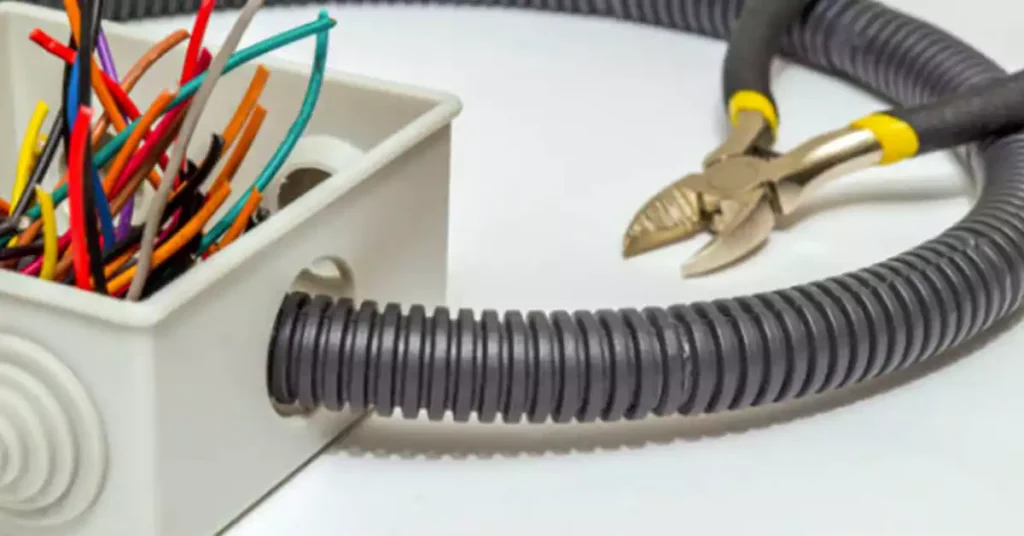
- تقييم الأضرار
ابدأ بتقييم شدة الضرر. يمكن غالبًا معالجة الشقوق البسيطة أو الخدوش السطحية باستخدام مادة مانعة للتسرب تعتمد على الإيبوكسي، وهي مصممة للإصلاح السريع والآمن على الأسطح الصغيرة. بالنسبة للجروح أو الكسور الأكبر حجمًا، قد تكون أكمام الإصلاح أو شريط التوصيل المتخصص ضرورية، بينما يجب استبدال الأقسام التالفة بشدة بشكل عام لضمان الموثوقية على المدى الطويل.
- احتياطات السلامة
السلامة هي الأهم عند العمل على أي مكون كهربائي. قبل البدء في الإصلاحات، افصل التيار الكهربائي عن قاطع الدائرة لتجنب مخاطر الصدمات الكهربائية. كما أن استخدام القفازات المعزولة وحماية العين يقلل من خطر الإصابة أثناء الإصلاحات، وخاصة عند التعامل مع الحواف الحادة أو المواد اللاصقة.
- تقنيات التصحيح
يتم استخدام تقنيات مختلفة اعتمادًا على مدى الضرر:
إصلاح مانع التسرب الإيبوكسي (للشقوق الصغيرة والخدوش): قم بتنظيف المنطقة التالفة جيدًا، ثم ضع مانع التسرب الإيبوكسي بالتساوي، واتركه حتى يجف تمامًا للحصول على مانع تسرب قوي ودائم.
غلاف إصلاح الأنابيب (للقطع أو الكسور الأكبر): قم بإزالة الجزء التالف، ثم ضع الغلاف فوق المنطقة وقم بتثبيته وفقًا لتعليمات الشركة المصنعة، مع ضمان إحكام الغلق على كلا الطرفين.
إصلاح شريط التوصيل (للفجوات الأكبر): لف المنطقة التالفة بطبقات من شريط PVC المتخصص، مما يؤدي إلى إنشاء ختم متداخل ومحكم الضغط يعزز سلامة البنية.
- عمليات التفتيش بعد الإصلاح
بعد الانتهاء من الإصلاح، قم بإجراء فحص بصري للتأكد من أن جميع التوصيلات آمنة وأنه لا توجد فجوات أو نقاط ضعف في المنطقة التي تم إصلاحها. إذا لزم الأمر، استشر كهربائيًا لاختبار الإصلاح للتأكد من أنه يفي بمعايير السلامة.
دليل شراء قنوات الأنف والأذن والحنجرة
عند شراء قناة الأنف والأذن والحنجرة، من المهم مراعاة العوامل التالية:
الجودة والامتثال: عند اختيار الأنف والأذن والحنجرة، يجب التأكد من امتثالها للوائح السلامة والجودة المحلية أو الدولية ذات الصلة.
الحجم والطول: قم بتحديد الحجم والطول المناسبين للأنبوب المطلوب لتطبيقك المحدد.
تصنيف: تأكد من أن الأنبوب مصمم للاستخدام المقصود، مثل الاستخدام الداخلي أو الخارجي.
يكلف: قم بمقارنة الأسعار من الموردين المختلفين مع مراعاة جودة القناة وتوافقها.
اعتبارات العلامة التجارية: يمكن أن تكون سمعة العلامة التجارية عاملاً مهمًا في قرار الشراء. ابحث عن العلامات التجارية الراسخة التي تتمتع بسجل حافل في تصنيع المنتجات الكهربائية عالية الجودة. ضع في اعتبارك العلامات التجارية المعروفة بخبرتها وتجربتها والتزامها بتميز المنتج.
الاتجاهات المستقبلية في تكنولوجيا أنابيب البولي فينيل كلوريد المرنة
تتطور تكنولوجيا أنابيب البولي فينيل كلوريد المرنة بسرعة، مع التطورات الجديدة التي تلبي المطالب المتزايدة بتركيبات كهربائية أكثر أمانًا وذكاءً واستدامة. ومع تبني المباني والبنية الأساسية للمتطلبات الحديثة، يتم تحويل أنابيب البولي فينيل كلوريد المرنة لتلبية هذه التحديات من خلال الابتكارات في علم المواد والمرونة البيئية والتكامل مع التقنيات الذكية.
- معايير السلامة من الحرائق المعززة
مع تزايد أهمية السلامة من الحرائق كجانب بالغ الأهمية في قوانين البناء، يجري تطوير أنابيب PVC المرنة ذات خصائص مقاومة للحرائق المحسنة. كما يجري العمل على طلاءات ومواد متقدمة مقاومة للحرائق لتوفير طبقات إضافية من الأمان، مما يساعد على إبطاء انتشار الحرائق في البيئات الحساسة. - تكامل التكنولوجيا الذكية
يتضمن مستقبل الأنابيب البلاستيكية المرنة التكامل السلس مع الأنظمة الذكية للمراقبة والتشخيص في الوقت الفعلي. يمكن أن تتميز الأنابيب المستقبلية بأجهزة استشعار مدمجة قادرة على تتبع الظروف مثل درجة الحرارة وتدفق التيار، والتي من شأنها أن تغذي البيانات مباشرة في أنظمة إدارة المباني الذكية. لا تعمل هذه القدرة على تعزيز السلامة فحسب، بل تسمح أيضًا بالصيانة التنبؤية، وتقليل وقت التوقف عن العمل وتحسين كفاءة الطاقة. - الاستدامة والمسؤولية البيئية
تعمل الاستدامة البيئية على إعادة تشكيل إنتاج البولي فينيل كلوريد، مع التحول نحو المواد والعمليات القابلة لإعادة التدوير والصديقة للبيئة. يتم توجيه الجهود نحو مركبات البولي فينيل كلوريد التي يمكن إعادة تدويرها بسهولة أكبر، مما يقلل من النفايات، ويعزز الاستخدام المسؤول للموارد. حتى أن بعض الشركات المصنعة تستكشف بدائل البولي فينيل كلوريد القائمة على المواد الحيوية أو منخفضة التأثير، مما يسمح بالتركيبات التي تراعي البيئة. - متانة متقدمة ومقاومة للطقس
مع تزايد الحاجة إلى تحمل التركيبات للطقس القاسي والتعرض للعوامل الخارجية، يتم تحسين مواسير البولي فينيل كلوريد المرنة لتكون أكثر مقاومة للأشعة فوق البنفسجية والتآكل. تضمن هذه التطورات أن المواسير يمكنها تحمل كل من التأثيرات المادية والتآكل البيئي، مما يوفر أداءً موثوقًا به حتى في الظروف الصعبة. - التخصيص والحلول حسب الطلب
تتجه تقنية أنابيب البولي فينيل كلوريد المرنة نحو خيارات تخصيص أكبر، بدعم من تقنيات التصنيع المتقدمة مثل الطباعة ثلاثية الأبعاد. وهذا يسمح للمقاولين بإنتاج أشكال وأحجام أنابيب متخصصة حسب الحاجة، مما يبسط عملية التركيب ويقلل من هدر المواد. ويتيح التخصيص إمكانية تصميم حلول مخصصة لاحتياجات المباني الفريدة والتخطيطات الكهربائية المعقدة.
خاتمة
توفر قناة ENT بشكل عام حلاً موثوقًا ومرنًا لحماية الأسلاك الكهربائية في التطبيقات المختلفة. بفضل أدائه الفيزيائي والكيميائي الممتاز، يمكن أن يكون خيارًا جيدًا بغض النظر عن الأنظمة الكهربائية السكنية أو التجارية. عند اختيار قناة الأنف والأذن والحنجرة، ضع في اعتبارك الحجم والطول ورمز الامتثال ومتطلبات المشروع والعوامل الضرورية الأخرى للتأكد من أنها تلبي احتياجاتك الخاصة.
هذا كل ما في المنشور. إذا كانت لديك أي أسئلة حول موصلات الكهرباء الخاصة بأجهزة الأنف والأذن والحنجرة، فلا تتردد في إرسال نموذج الاتصال أو مراسلتنا عبر البريد الإلكتروني.



